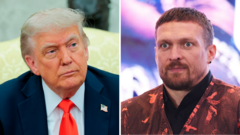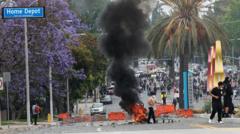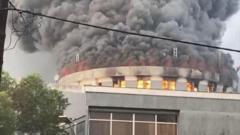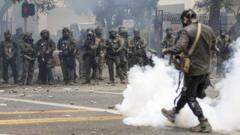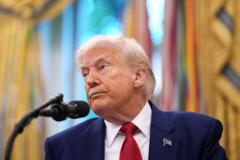As protests against ICE operations erupt in Los Angeles, former President Donald Trump is leveraging the moment to reaffirm his commitment to law and order, a move that poses potential political ramifications ahead.
Trump Seizes Opportunity in LA Immigration Protests to Reinforce Law and Order

Trump Seizes Opportunity in LA Immigration Protests to Reinforce Law and Order
The former president cites public safety concerns while Democrats criticize his heavy-handed approach.
On the campaign trail, Trump had vowed to combat left-wing lawlessness in America, and the recent protests against Immigration and Customs Enforcement (ICE) in California presented an opportunity for him to follow through on that pledge. Despite the Los Angeles Police Department (LAPD) characterizing the protests as predominantly peaceful, Trump and his administration claimed that immigration agents were under threat and accused local authorities of responding too slowly to escalating tensions.
“Waiting several hours for LAPD to show up is unacceptable during violent protests,” said Homeland Security Secretary Kirsty Noem in a recent CBS interview, emphasizing the urgency of the situation. The LAPD, however, maintained that they acted promptly, dispersing crowds in under an hour.
In a controversial move, Trump authorized the federalization of 2,000 California National Guard soldiers, despite pushback from California Governor Gavin Newsom. This activation, along with warnings from Defense Secretary Pete Hegseth about the readiness of U.S. Marines, signals a rare use of active-duty military personnel on U.S. soil.
By Sunday morning, Trump claimed victory, asserting that the presence of the National Guard had successfully restored order, even as the troops were still mobilizing. His administration is keen on portraying a strong stance on law enforcement and immigration, hoping it will resonate with his loyal voting base while possibly appealing to centrist voters worried about safety.
Noem likened the situation to the Black Lives Matter protests of 2020, asserting that the Trump administration would not allow such protests to escalate unchecked. However, dissent from Democrats is growing. Senator Cory Booker criticized the administration’s tactics, arguing that deploying military personnel without a formal request is inflammatory and likely to escalate tensions rather than diffuse them.
The summer has historically been a season rife with protests in the U.S., and early June may well mark the beginning of broader civil unrest. With this latest Hail Mary from Trump, whether it will remain an isolated incident or ignite further protests in the weeks to come remains uncertain.
“Waiting several hours for LAPD to show up is unacceptable during violent protests,” said Homeland Security Secretary Kirsty Noem in a recent CBS interview, emphasizing the urgency of the situation. The LAPD, however, maintained that they acted promptly, dispersing crowds in under an hour.
In a controversial move, Trump authorized the federalization of 2,000 California National Guard soldiers, despite pushback from California Governor Gavin Newsom. This activation, along with warnings from Defense Secretary Pete Hegseth about the readiness of U.S. Marines, signals a rare use of active-duty military personnel on U.S. soil.
By Sunday morning, Trump claimed victory, asserting that the presence of the National Guard had successfully restored order, even as the troops were still mobilizing. His administration is keen on portraying a strong stance on law enforcement and immigration, hoping it will resonate with his loyal voting base while possibly appealing to centrist voters worried about safety.
Noem likened the situation to the Black Lives Matter protests of 2020, asserting that the Trump administration would not allow such protests to escalate unchecked. However, dissent from Democrats is growing. Senator Cory Booker criticized the administration’s tactics, arguing that deploying military personnel without a formal request is inflammatory and likely to escalate tensions rather than diffuse them.
The summer has historically been a season rife with protests in the U.S., and early June may well mark the beginning of broader civil unrest. With this latest Hail Mary from Trump, whether it will remain an isolated incident or ignite further protests in the weeks to come remains uncertain.


